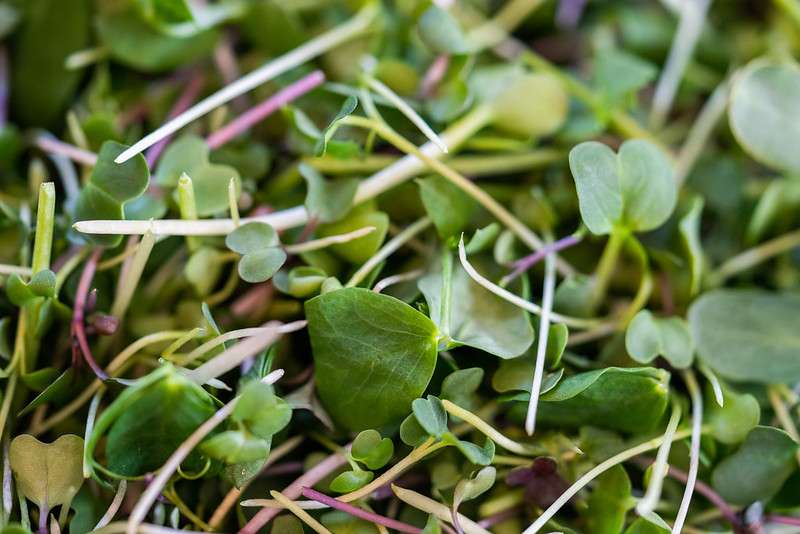Microgreens are easy to grow and requires minimum effort from you. Compared to fully grown plant, microgreens takes less time to get the yield.
There are different varieties of basil microgreens to grow. Genovese basil are one of the most common microgreen variety.
If you want to have purple colored basil microgreens then opt for opal basil variety.
Growing process for all these varieties are nearly same.
Growing Basil Microgreens at Home

Things you’ll need to grow basil microgreens:
- Basil seeds variety of your choice
- Organic potting mix or soil
- A trays to sow the seeds
- Water to moisturize basil seeds
- Sunlight or grow lights
Now, you’ve all the essential things to kick start your journey of growing basil microgreens.
Also Read: How to Grow Lettuce Microgreens?
Prepare Container
Before you sow the seeds, it is important to prepare the container for growing microgreens. Start by selecting a shallow tray or container with adequate drainage holes that can hold the soil and moisture in place. For best results, use a container that is at least 2 inches deep and 6-8 inches wide.
Potting Soil Mix to Grow Basil Microgreens
When it comes to potting soil mix for microgreens, it is important to choose a light and airy mix that drains well. A sandy loam potting mix with organic matter such as compost or peat moss works best. It should be free of chemicals, pesticides and weed seeds. The ideal pH of the soil should be 6.5 to 7.0 for basil microgreens.
Choose Basil Seeds
As mentioned there are different types of basil seeds, most common being Genovese and Opal varieties. Choose the variety based on your preference and availability.
Different types of basil seeds varieties are: Genovese basil, Opal basil, Thai basil, Sweet basil and Lemon basil.
Check this out: How to Grow Spinach Microgreens?
Step-by-step Process to Grow Basil Microgreens
- Prepare the trays for sowing. Fill the tray with moistened organic potting mix up to ¼ inch depth.
- Spread the basil seeds evenly across the tray and then cover it with a thin layer of vermiculite.
- Place the tray in a bright and sunny spot.
- Make sure that the soil is kept moist at all times. If necessary, give them occasional misting to maintain the moisture level.
- Basil microgreens should show up within few days.
- Once they are about 1-2 inches tall, your basil microgreens are ready to harvest!
- Trim them off at soil level using scissors or harvesting knife.
You can also try growing multiple varieties of basil microgreens for an exciting flavor experience! Enjoy your fresh harvest as garnish on salads, sandwiches or other dishes!
Tips While Growing Basil Microgreens
1. Make sure to choose organic potting mix as it’s free from weed-killers and synthetic nutrients.
2. Always water the basil microgreens from the bottom. Overhead watering can cause damping off, which is a fungal disease that can have devastating effects on your microgreens.
3. Monitor the moisture content of your soil and make sure that it does not dry out completely.
4. If you are growing them indoors, use grow lights to ensure that they get enough light for optimum growth.
5. Do not grow too many varieties of basil microgreens in one tray as this will reduce their yields significantly.
6. Harvest basil microgreens when they are about 1-2 inches tall.
7. Store the harvested basil microgreens in the refrigerator and enjoy them within a week after harvesting.
With simple to follow steps, you can have your own crop of delicious and healthy basil microgreens at home! Get started today and enjoy the fresh harvest for weeks.
Is it safe to grow microgreens indoors?
Yes, growing microgreens indoors is completely safe and can be done with minimal efforts. All you need is a suitable container, organic potting mix, a source of good light and moisture. Follow the above steps to grow basil microgreens indoors for best results.
Do I need grow lights to grow microgreens?
Grow lights are not necessary for growing microgreens indoors. However, they can help to increase the yield significantly and provide plants with the needed energy. If you are growing microgreens indoors without light, make sure to place the container near a sunny window or have grow lights set up for optimum growth.
How many hours a day should a grow light be on?
Grow lights should be on for 14 to 16 hours a day to provide maximum light intensity. If you are using natural sunlight, make sure to rotate the containers regularly to ensure that all sides get sufficient light.
Are basil microgreens easy to grow?
Yes, basil microgreens are relatively easy to grow. All you need is a suitable container, some good quality potting soil and adequate light.
Keep the soil moist and make sure to trim them off when they are 1-2 inches tall. With simple steps, you can have your own crop of delicious and healthy basil microgreens in no time.
Conclusion
Basil microgreens are a deliciously healthy addition to any meal. With minimal effort, you can easily grow your own basil microgreens indoors and enjoy their fresh harvest for weeks. Make sure to choose an organic potting mix, keep the soil moist and use grow lights if needed. Harvest them when they are 1-2 inches tall and store them in the refrigerator. With these few easy steps, you can have your own crop of delicious basil microgreens at home.
